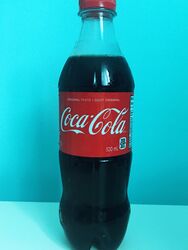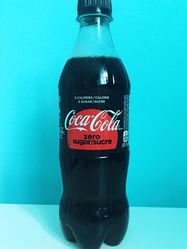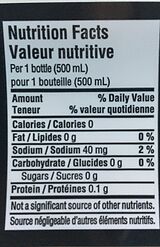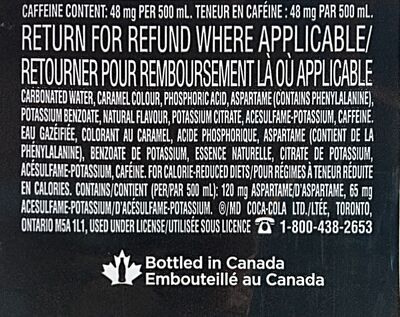Course:FNH200/Assignments/2020/Coca Cola Original and Coca Cola Zero
Introduction
| Coca-Cola, or Coke, is a carbonated non-alcoholic beverage that has been growing in popularity over the last 125 years.[1] It originated as a patent medicine product but has since become the most popular soft drink in Canada, alongside its sugar-free counterpart Diet Coke.[2] With so many people enjoying sugary beverages like Coke, it is understandable that some individuals would seek out a health-conscious alternative, addressing concerns related to weight gain, diabetes, and oral health. However, with the creation of 0-sugar, 0-calorie drinks like Coke Zero, many other health concerns and controversies have arose.[3] To discern between classic Coke and its 0-calorie alternative, we investigate their lists of ingredients, the differences between them, and what their labels tell us about what’s in the bottle to help clarify some of the questions that have bubbled up over the years. |
Ingredient Lists
See later sections for images of the ingredients list, as defined below.
Coca Cola Original
- Carbonated water
- Sugar/glucose-fructose
- Caramel colour
- Phosphoric acid
- Natural flavour
- Caffeine
Coca Cola Zero
- Carbonated water
- Aspartame (contains phenylalanine)
- Caramel colour
- Phosphoric acid
- Natural flavour
- Caffeine
- Potassium benzoate
- Potassium citrate
- Acesulfame-potassium
Sugar Substitutes and Additives
There are two sugar substitutes that can be found in Coke Zero:
- Aspartame, being 180-220 times sweeter than sucrose, is used as a low calorie sweetener alternative to sucrose (table sugar). Zero-sugar product alternatives that contain aspartame are often chosen by individuals with diabetes, as the consumption of aspartame does not increase blood glucose or insulin levels.[4] The acceptable daily intake, as stated by Health Canada, is 40mg/kg body weight, but as the quantity of aspartame needed to sweeten beverages is so small, there is minimal risk posed with moderate consumption. The caveat to this health risk is for individuals with Phenylketonuria (PKU), a rare metabolic disorder characterized by an increased amount of phenylalanine in the blood.[5] Phenylalanine is an amino acid present in aspartame, and if consumed by individuals with PKU, could build up to harmful levels and result in brain damage or other health problems.[1]
- Acesulfame-potassium (Ace-K) is a non-caloric sweetener used as an alternative to sucrose (sugar) that can provide a synergistic sweetening effect alongside other sweeteners like aspartame. It is 200 times sweeter than sucrose and is not metabolized by the body (hence non-caloric). The acceptable daily intake as stated by Health Canada is 15mg/kg body weight.[6] Acesulfame-potassium is also heat stable, meaning that it has a high degree of stability over a considerable range of pH and temperature conditions, allowing storage temperatures to be more flexible. It is also not fermented by oral bacteria which means it does not contribute to cavity development.
There are several additives in both products that have been added to improve the flavour and colour of the beverage, bettering the consumer experience:
- Caramel colour, or more scientifically known as E150d, is a food colourant added to Coke to give the drink its well-recognized dark brown colour.[1] The colouring agent is permitted by Health Canada[7] and has been an additive in Coke since 1886.[1] Without it, factors such as processing and storage could affect the familiarity of the product by compromising the uniformity of the colour, impacting the consumer’s decision to drink Coke.[8]
- Phosphoric acid is a corrosive, clear, colourless liquid used in fertilizer manufacturing, as a reagent in laboratories, and in the food industry as a pH-adjusting additive.[9] It not only contains phosphorus, which is conducive to good health, but it is also an integral component in the flavour profile of Coca-Cola products, providing a distinct tang.[1]
- Natural flavour constitutes part of the Coca-Cola recipe that has been used for over 125 years, but is simply a blend of plant extracts that is safe for consumption.[1] Although the precise recipe is a closely guarded secret, the components of this flavouring likely consist of nutmeg, vanilla, lemon, cinnamon, coriander, and neroli.[10]
There are also two other additives that exist solely in Coca Cola Zero, for flavour and shelf life enhancement:
- Potassium benzoate is a common preservative added to beverages to prevent bacterial growth.[1]
- Potassium citrate is an ingredient used to “mask some of the acidity of carbonated soft drinks … important in diet sodas, as their sugar replacements often have a less enjoyable flavour on their own.”[11] According to Health Canada, potassium citrate is a Permitted pH Adjusting Agent, Acid-Reacting Material or Water Correcting Agent.[12]
Ingredient List Comparison
| Ingredients | Coke | Coke Zero |
|---|---|---|
| Carbonated Water | ✔️ | ✔️ |
| Sugar/Glucose-Fructose | ✔️ | |
| Aspartame (contains phenylalanine)
[artificial sweetener] |
✔️ | |
| Caramel Colour | ✔️ | ✔️ |
| Phosphoric Acid | ✔️ | ✔️ |
| Natural Flavour | ✔️ | ✔️ |
| Caffeine | ✔️ | ✔️ |
| Potassium Benzoate
[preservative] |
✔️ | |
| Potassium Citrate | ✔️ | |
| Acesulfame-Potassium
[artificial sweetener] |
✔️ |
Both original Coke and Coke Zero share 5 of the 6 main ingredients, the main difference being the sugar substituted aspartame and acesulfame-potassium (Ace-K), which allows the label for Coke Zero to read “0 calories, 0 sugar,” and the additives potassium benzoate and potassium citrate.
What is the same?
Carbonated Water
Both Classic Coke and Coke Zero are made up mostly of carbonated water. People have consumed carbonated water for centuries to combat upset stomach, and there is research to suggest it can soothe dyspepsia and constipation symptoms.[13] Our descendants consumed naturally-occurring sparkling water; whereas, Coca-Cola manufacturers utilize equipment to inundate water with carbon dioxide under pressure to add the ‘fizz’ associated with pop beverages.[1] The bubbly water provides a desirable mouth feel and is essential for consumer enjoyment.
Caffeine
Both products contain the same amount of caffeine, which is crucial for consumer retention. People may be unlikely to choose Coke Zero as an alternative if it did not provide the same experience. Caffeine not only has an alerting effect on the consumer, but also contributes a bitter flavour to the recipe due to the presence of alkaloids.[14]
Additives
The additives: caramel colour, phosphoric acid and natural flavour, are present in both beverages. The purpose of these additives are discussed in an earlier section.
What is Different?
Sugar
While the large majority of both regular Coke and Coke Zero is water, only regular Coke contains 55 grams of sugar per 500ml serving, which is a lot of sugar; just over a ¼ cup! Canada’s Dietary Guidelines advise that sugary beverages, such as Coke, are products that undermine health in numerous ways, and so they recommend not to consume them regularly.[15] Coke Zero offers soda enthusiasts an avenue to continue enjoying the product without excessive refined sugar intake. Sucrose cannot be removed from Coke without drastic effect to consumer enjoyment; thus, additives such as aspartame and Ace-K take on the role of sweetener instead. The dietary guidelines assure Canadians that these sweeteners are strictly regulated to ensure their safety, but the official recommendation is to focus on unsweetened options instead.[15]
Aspartame
As prior mentioned, aspartame is a low-calorie sweetener that is 180-220 times sweeter than sugar, meaning less aspartame is needed in the recipe to get the same sweet taste. Aspartame contributes 4 calories/g when it is metabolised,[4] but as there are only 120mg per bottle of Coke 0 there are essentially no calories. As the result of regular thorough reviews, Aspartame has been declared a safe ingredient for use in countries all over the world.[1] It is used in conjunction with acesulfame-potassium (Ace-K) to create a balanced, palatable taste (see below).
Acesulfame-Potassium (Ace-K)
Ace-K has a similar level of sweetness as Aspartame, roughly 200 times that of sugar, but unlike aspartame it is non-caloric.[1]
Potassium Benzoate
Potassium benzoate is used as a preservative in soft drinks to prevent microbial growth,[16] but why is it listed in the ingredients for Coke 0 and not regular Coke? This could be because the sugar present in regular Coke acts as its own preservative, but it has also been found that aspartame is unstable when stored at uncontrolled temperatures, and so to avoid the substance losing its necessary sweet flavour is in need of additional preservation.[17]
Potassium Citrate
A physician may prescribe potassium citrate tablets to treat acidosis resulting from kidney disease, or as a preventative measure against gout and kidney stones.[18] As an additive in food products such as infant formula and Coke Zero however, potassium citrate primarily acts as a buffer to adjust pH and to conceal acidity [Health Canada]. This is especially important for Coke Zero because the replacements for sugar are not as enjoyable on their own.[11]
Labels
Main Label
There is a lot of essential information prominently shown on the main label for both regular Coke and Coke Zero: product name (“Coca-Cola” for regular Coke and “Coca-Cola Zero Sugar” for Coke Zero), net quantity of the beverage (500mL), bottle recycling symbol, and calorie claims. All mandatory information on the food labels is shown in both official languages of Canada, French and English, which complies with rules in Section 206(1) of the Safe Food for Canadians Regulations (SFCR) and Section B.01.012(2) of the Food and Drug Regulations (FDR).[19][20] Information on both labels meets the legibility requirement, with large enough text and large enough contrast between the text and the background (Section A.01.016, FDR; Section 208, SFCR).[19] [20] Since there is no prescribed name in the FDR for Coke, as it is not “standardized food”,[21] the coined name ‘Coke’ is also listed as it has become well-known over a long period of time (Section B.01.006, FDR; Section 218(1)(a), SFCR).[19][20] As mentioned, net quantity is also presented for the volume in millilitres (mL) as required by SFCR (Section 221).[19]
Moreover, both labels contain some diet-related claims and statements. They list the amount of calories contained per bottle, “200 cal per bottle” for regular Coke and “0 cal per bottle” for Coke Zero. Above the main product name, “original taste” is shown for regular Coke and “0 calories” is shown for Coke Zero. Additionally, Coke Zero contains the capitalized statement “calorie-free cola with/avec aspartame and/et acesulfame-potassium”, while regular Coke does not. The claims on Coke Zero regarding the calorie contents are the legally required if the drink contains less than 5 calories (Section B.01.401(3), FDR).[20] The sweetener-added statement for Coke Zero also complies with the labeling requirements for prepackaged products that contain aspartame in conjunction with other sweeteners such as acesulfame-potassium in Coke Zero. The statement is declared in letters that are the same size and prominence as the numerical portion of the net quantity declaration in compliance with the rules (Section B.01.014, B.01.015, B.01.016, B.01.017, B.01.019, B.01.020, B.01.022, B.01.023, FDR).[20]
Nutritional Facts Label
Both product labels have a simplified-format nutrition facts table that shows the quantity of calories, fat, sodium, carbohydrates, sugar, and protein per serving size, and as a percentage of daily value. The serving size used is one bottle, which is in compliance with the requirement for single-serving pre-packaged products (Section B.01.002A(2)(a), FDR).[20] The quantity of every item per serving is also rounded off according to the FDR. For example, Energy(Calories) for Coke Zero is rounded to and presented as 0 calories since the total amount of calories per bottle is less than 5 Calories (Section B.01.401, FDR).[20] Both versions of Coke satisfy the simplified-format nutrition facts table since they contain a limited number of nutrients. Both labels have the footnote on the nutrition facts table that states there are “not a significant source of other nutrients” in compliance with the rules for simplified-format nutrition facts table (Section B.01.401, FDR).[20]
List of Ingredients Label
There are several important pieces of information that can be found in the ingredients section of the label. The main item is the ingredients list, offered in both English and French as per Section 206(1) of the SFCR and Section B.01.012(2) of the FDR regulations.[19][20] The list also follows the requirement that ingredients are to be listed in descending order of proportion (eg. carbonated water comes first as it takes up around 90% of the drink)[1]. In Coke Zero, there is one interesting addition beside aspartame, which states that it contains phenylalanine. The addition of this piece of information is a result of the labelling requirements for products that contain aspartame.[22]
Alongside the list of ingredients, both labels also report the net quantity of some key ingredients. The ingredient common to both products is caffeine, reported at 48mg per the 500mL bottle. While addition of caffeine is permitted to a certain quantity in beverages, its quantity must be listed, so this packaging is in compliance to that rule.[23] The Coke Zero product also lists the quantity of aspartame (65mg) and acesulfame-potassium (120mg), both of which are sweeteners. This is in compliance with the labelling of sweetener quantities regulation.[23] Following the ingredients, there is information about the company name, phone number and principal place of business. As this is a Canadian company, manufacturing and selling a product that they do not own, there is also a note that this product is licensed (from the American Coca Cola Company). All of these items comply with the requirements related to labeling company information and location. The packaging also makes the claim that the product was “Bottled in Canada”. It is important to note that this likely means that the drink itself was not produced in Canada, or the ingredients were not Canadian sourced. Had this been the case, the company could have made a stronger claim, such as “Made in Canada”.[24]
References
- ↑ 1.00 1.01 1.02 1.03 1.04 1.05 1.06 1.07 1.08 1.09 1.10 "What is in Coca-Cola?" (PDF).
- ↑ statista. "Favorite beverages among consumers in Canada as of June 2018".
- ↑ Strawbridge, Holly. "Artificial sweeteners: sugar-free, but at what cost?".
- ↑ 4.0 4.1 "FNH200 Lesson 3: Low-calorie Sweeteners".
- ↑ NIH. "Phenylketonuria".
- ↑ Diabetes Canada. "Sugars and Sweeteners" (PDF).
- ↑ "List of Permitted Colouring Agents (Lists of Permitted Food Additives)".
- ↑ "FNH200 Lesson 3: Appearance Factors".
- ↑ "Phosphoric Acid (Solutions)".
- ↑ Coldwell, (newspaper Independent). "Not quite the real thing: Coca-Cola's 'secret formula' is out of the bottle - but can the famous flavour be recreated at home?".
- ↑ 11.0 11.1 Sturm. "Potassium Citrate, Keeping Your Food Fresh for Longer".
- ↑ Health Canada. "10. List of Permitted pH Adjusting Agents, Acid-Reacting Materials and Water Correcting Agents (Lists of Permitted Food Additives)".
- ↑ Canadian Society of Intestinal Research. "Carbonated Water May Help Dyspepsia & Constipation".
- ↑ "FNH200 Lesson 3: Bitter".
- ↑ 15.0 15.1 Health Canada. "Canada's Dietary Guidelines for Health Professionals and Policy Makers" (PDF).
- ↑ Mandl, Elise. "Diet Soda: Good or Bad?".
- ↑ Yakici, Tulin; Arici. "Storage Stability of Aspartame in Orange Flavored Soft Drinks". International Journal of Food Properties.
- ↑ HealthLinkBC. "Potassium Citrate Tablet - Oral".
- ↑ 19.0 19.1 19.2 19.3 19.4 Government of Canada. "Safe Food for Canadians Regulations (SOR/2018-108)".
- ↑ 20.0 20.1 20.2 20.3 20.4 20.5 20.6 20.7 20.8 Government of Canada. "Food and Drug Regulations (C.R.C., c. 870)".
- ↑ Health Canada. "Standards of identity for food".
- ↑ Health Canada. "Mandatory labelling of sweeteners".
- ↑ 23.0 23.1 Health Canada. "Preliminary Guidance for Industry on the Labelling of Caffeine Content in Prepackaged Foods (March 2010)".
- ↑ Health Canada. "Origin claims on food labels Guidelines for "Product of Canada" and "Made in Canada" claims".







